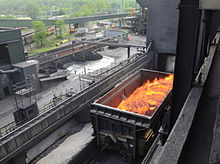coke
Coke (from English coke , more rarely coaks) is a porous, high carbon fuel with a high specific surface, which is produced from coal by the action of heat under the exclusion of oxygen ( pyrolysis ), whereby the volatile components of the coal are separated. Burning coke produces less smoke, soot and sulfur than coal. Coke is used in blast furnaces and for heating.
Coking
The process of coking coal to coke takes place in special industrial plants called coking plants . Low-ash fatty coal ( hard coal ) is preferably used as the starting material. The volatile components of the coal are removed by heating it in an oven with the exclusion of air at more than 1000 ° C, so that the solid carbon and the remaining ash fuse.
The products of the pyrolysis and distillation process are pyrolysis gases (raw coke gas), pyrolysis coke and condensable components (water, tar , sulfur ). The volatile constituents form the coking plant raw gas , from which other valuable substances are extracted, especially coal tar , raw benzene , sulfuric acid and coking plant clean gas, which was previously used as town gas and is now an energy source in many steelworks .
After extinguishing (cooling with water), coke has a grain size of slightly more than 0 to about 200 mm. Depending on the area of application, coke is classified into types of coke by sieving, if necessary after breaking. A distinction is made between blast furnace coke, crushed coke and coke breeze. The blast furnace coke (HK) is divided into the types HK 1 (> 80 mm), HK 2 (> 60 mm), HK 3 (> 40 mm) and HK 4 (> 20 or 25 mm). Today the HK 4 type is the common type of blast furnace coke, with the lower grain limit being set at 20 and the upper at 100 mm. The crushed coke (RK) is available in the types RK 1 (100–60 mm), RK 2 (60–40 mm), RK 3 (40–20 mm), RK 4 (20–10 mm) and RK 5 (10– 6 mm). Coke burrs usually have a grain size of 10–0 mm.
history
Coking was developed in England in 1713 , from 1740 the blast furnaces were charged with coke, an invention of Abraham Darby . In 1796 , coke was used for the first time in Germany , in Gleiwitz in Upper Silesia , to fire blast furnaces. The first coke oven in the Ruhr area was started up in 1849, but here (at the Sälzer and Neuack collieries ) coal was processed into coke as early as 1816. Before that, charcoal was used in the blast furnaces.
Types of coke
If raw lignite is coked, Grudekoks is created , usually as a waste product of the coking referred to here. The main goal of carbonization is to extract the volatile components contained in lignite, which is particularly rich in bitumen ( montan wax production ). In the 1960s, the BHT process was developed in the GDR due to the lack of coking coal . Here are brown coal - briquettes coked to produce a high-ovenable coke from the fact unsuitable lignite.
use
metallurgy
Coke from coal is used in particular as a fuel and as a reducing agent in iron production in blast furnaces . Bituminous coal itself is not suitable for this because too much sulfur, soot and smoke are released when it is burned . On the one hand, this contaminates the iron obtained and also leads to a relatively porous layer of coal in the blast furnace, which quickly breaks under the load of the layers above and therefore leads to unfavorable mixing.
In metallurgy, a distinction is made between metallurgical coke, foundry coke (which is coked a little longer at a lower temperature) and special coke , as well as mine coke (made from hard coal ) and lignite coke .
heater
Crushed coke 2 or crushed coke 3 is common for firing in the household. Grain that is too small falls through the grate, grain that is too large can prevent it from sliding down.
Coke has a calorific value of 23–31 MJ / kg.
See also
Individual evidence
literature
- Walter Buschmann (Ed.): Coke, Gas, Coal Chemistry. History and representational tradition of coal refinement. Klartext, Essen 1993, ISBN 3-88474-028-8 .
- Michael Farrenkopf (Ed.): Koks. The story of a valuable resource. German Mining Museum, Bochum 2003, ISBN 3-921533-90-2 (2 volumes).

